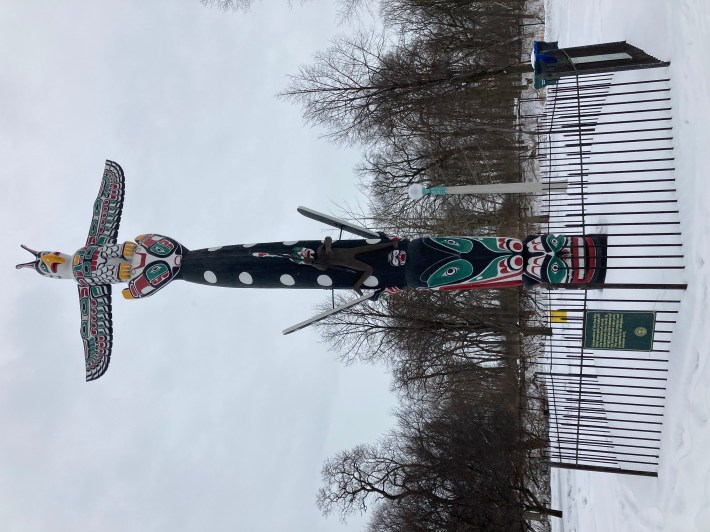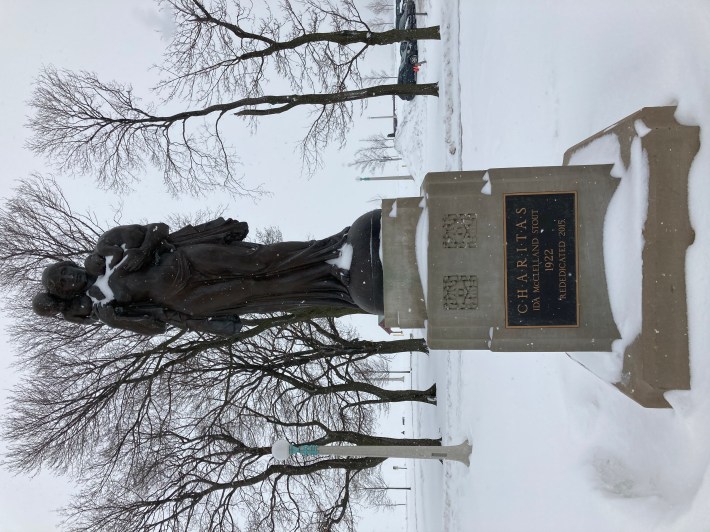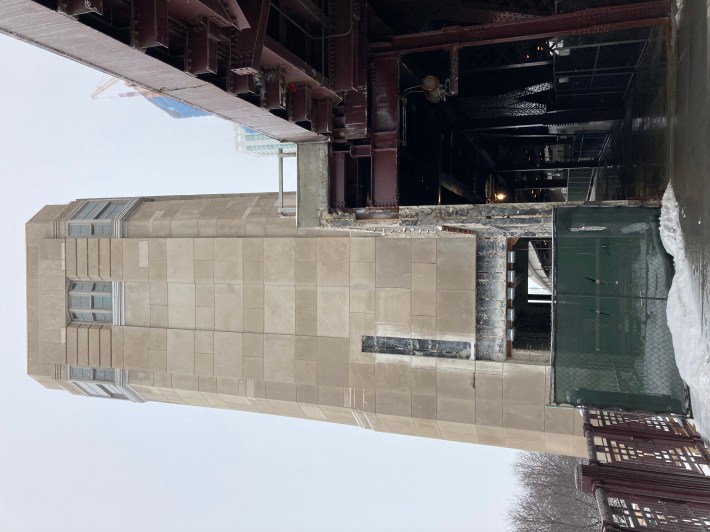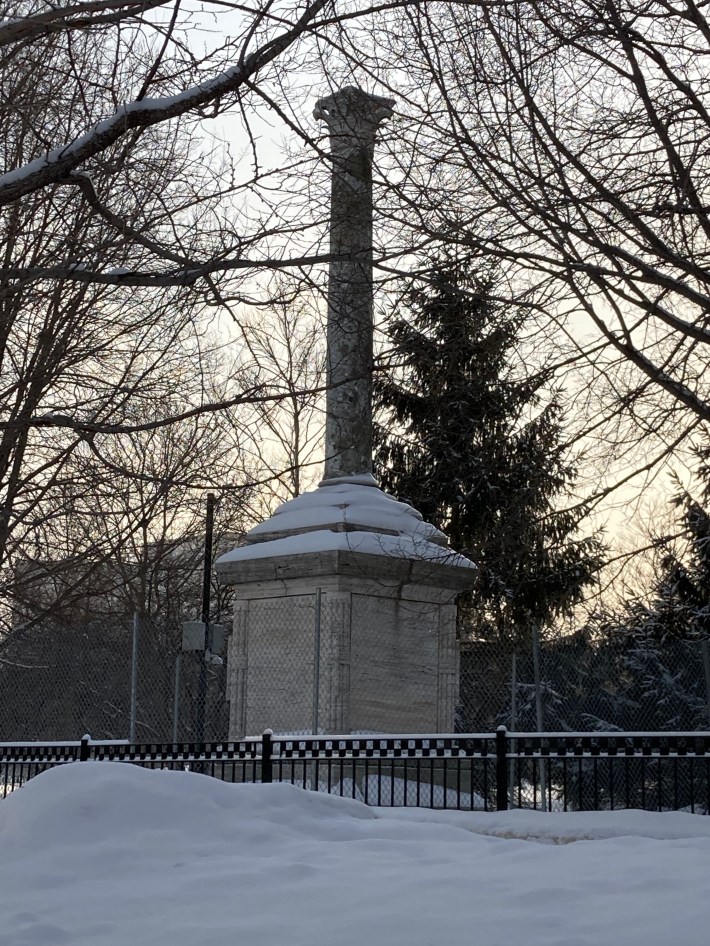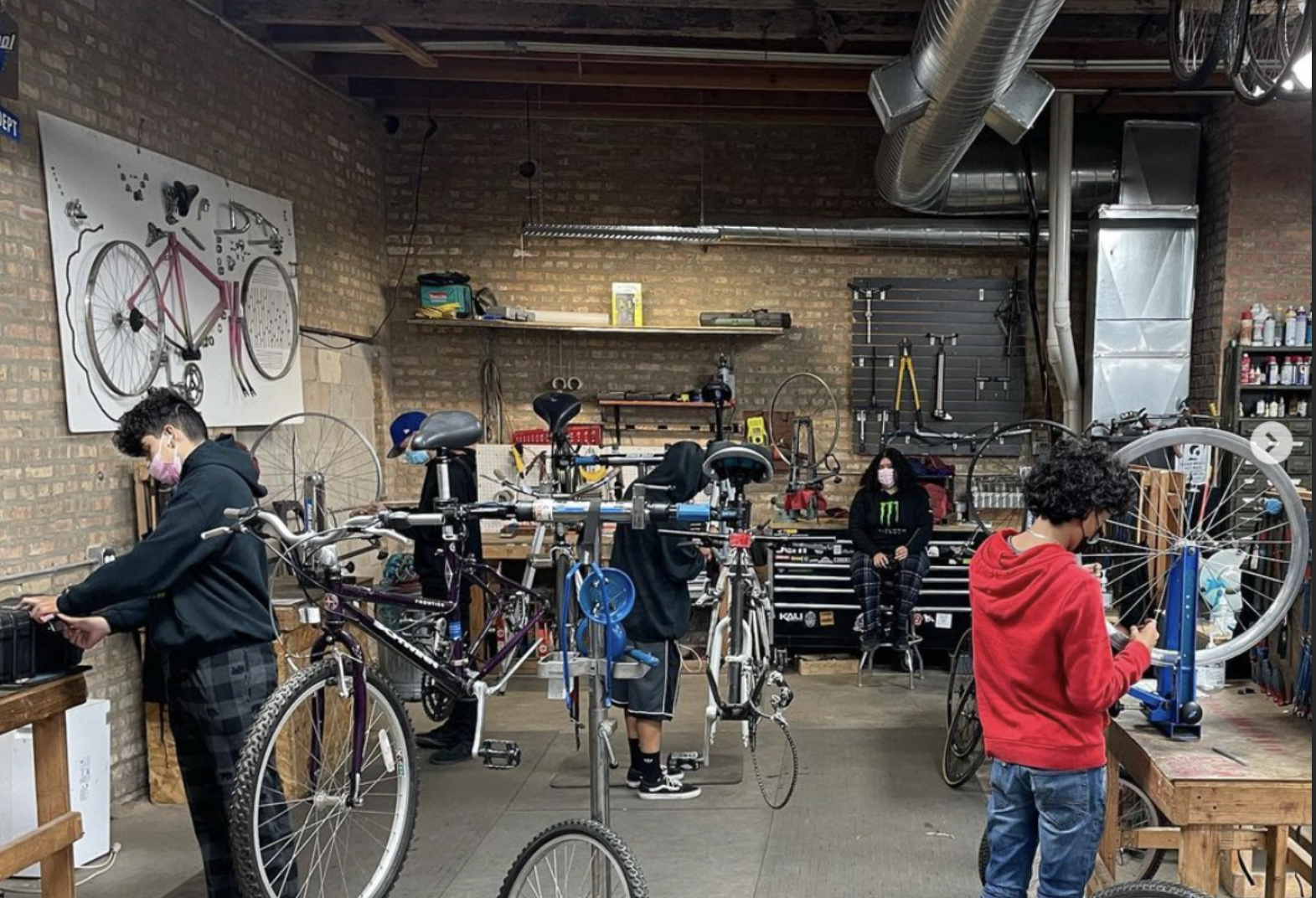Pondering the Chicago Monuments Project while skiing the entire Lakefront Trail
11:00 AM CDT on March 29, 2021
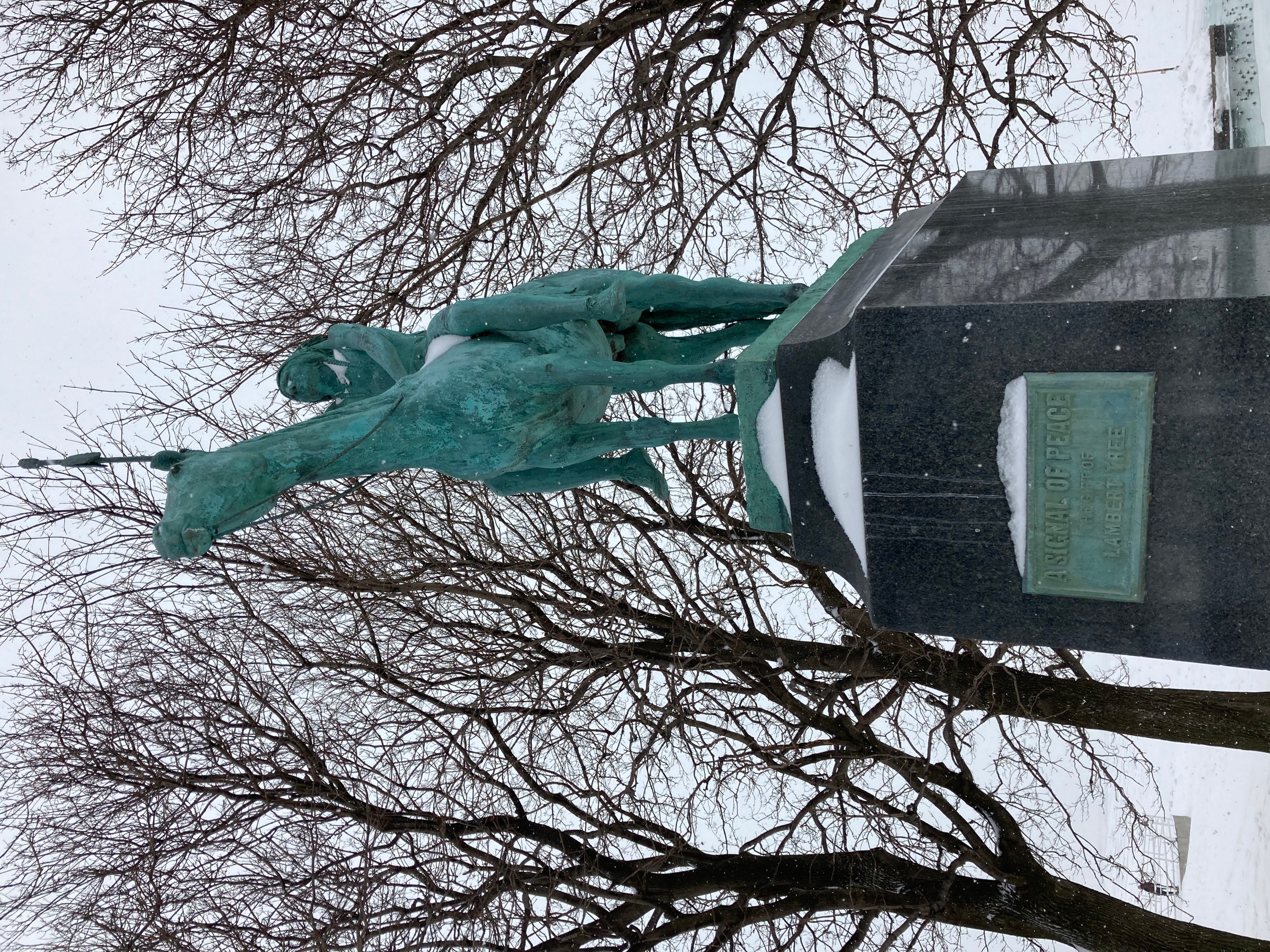
“A Signal of Peace” by Cyrus E. Dallin, located next to Diversey Harbor, is one of the 41 sculptures on the Chicago Monuments Project list for possible removal. Photo: John Greenfield
[A version of this article previously ran in the Chicago Reader. Here's the much longer original draft, with additional material and photos.]
While being mindful of the fact that heavy snowfall makes life more difficult for many Chicagoans, I have to say that in some ways this unusually snowy winter was a blessing during COVID-19. At a time when hanging out inside indoor public spaces was not a great idea, the plentiful white stuff gave people more options for having fun outside and beating cabin fever. Residents seemed to be having a great time making snow sculptures, sledding, and exploring the beaches, checking out the surreal drifts and ice formations. (It was important to stay off the shelf ice, though.)
Personally, I took advantage of the precipitation nearly every day of January and February by snowshoeing, biking snowy streets on a fat-tired cycle, and, especially, cross-country skiing. I find XC skiing to be an especially relaxing and scenic way to get physical activity.
I know I'm not alone in that respect, since this winter it seemed like I saw more people than ever before Nordic skiing on the Chicago lakefront. This ski boom paralleled the spike in biking (and, tragically, cycling deaths) that happened last year are people sought socially-distanced forms of transportation and recreation during the pandemic. And just as there has been a shortage of new bikes in local shops, I've heard new cross-country skis were hard to come by this winter, although you could always scour the thrift stores.
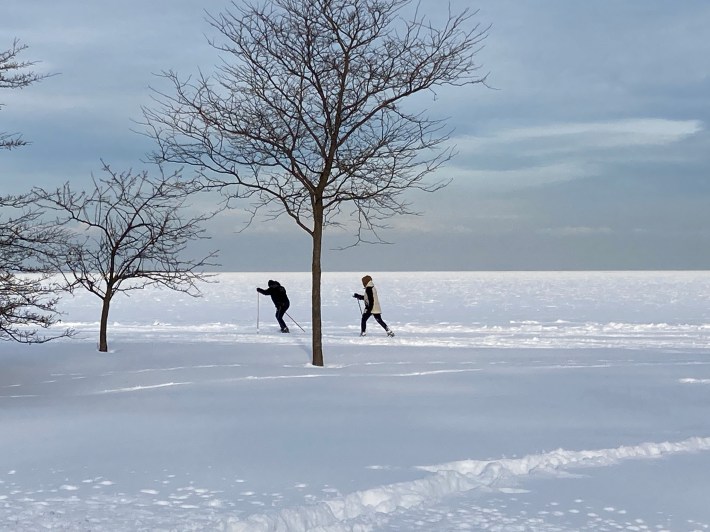
During the great blizzard of 2011, when more than 20 inches paralyzed our city, and hundreds of vehicles were eerily abandoned on Lake Shore Drive for a day or two, I snowshoed the entire 18.5-mile Lakefront Trail from South Shore to Edgewater in one day. That was an epic adventure, but it was something of an Into the Wild-style death march, and I didn't have much time to check out the sights along the way.
Since I'd been exploring new shoreline skiing routes this year, I figured I'd give the Lakefront Trail trip another go from north to south on skis, unclipping and hiking where necessary. Since I assumed it would be a swifter mode than snowshoes, I'd stop and smell the roses whenever I felt like it.

On the morning of February 13, with the mercury in the low single digits Fahrenheit, I bundle up in lots of layers and board the Red Line in Uptown with my skis. A guy in my car asks for a light. Fed up with the epidemic of smoking on the 'L' I've noticed during COVID, when ridership has plummeted, I say without thinking. “You want a light to smoke on the train? You’re not supposed to smoke on the train, my friend.” Luckily, instead of getting angry, he just shrugs and switches cars.
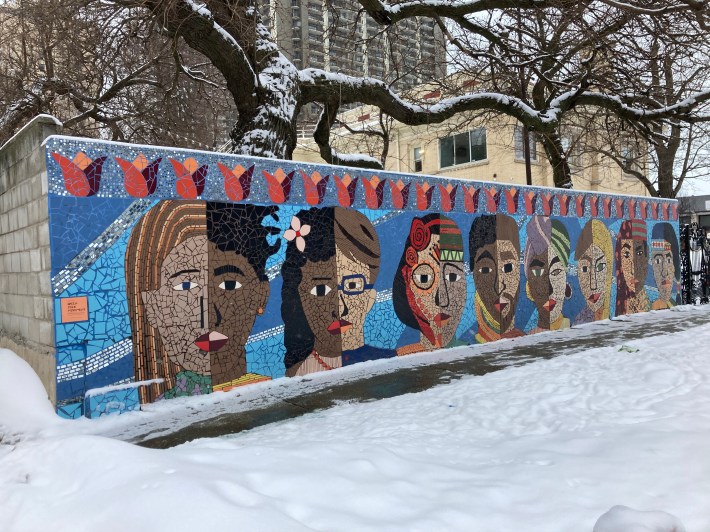
Exiting at Thorndale, I walk a few blocks east to the eponymous Beach and, north of which the shoreline is privatized. Just south is the Thorndale Beach Condominium building, 5901 N. Sheridan Ave. where Bob Newhart's psychologist character lived in his 1970s sitcom. A lady walking her dog looks at my skis and says, “This is your kind of weather, huh? She’s cold.” “I bet!” I say, before stepping into my bindings to start my trip.
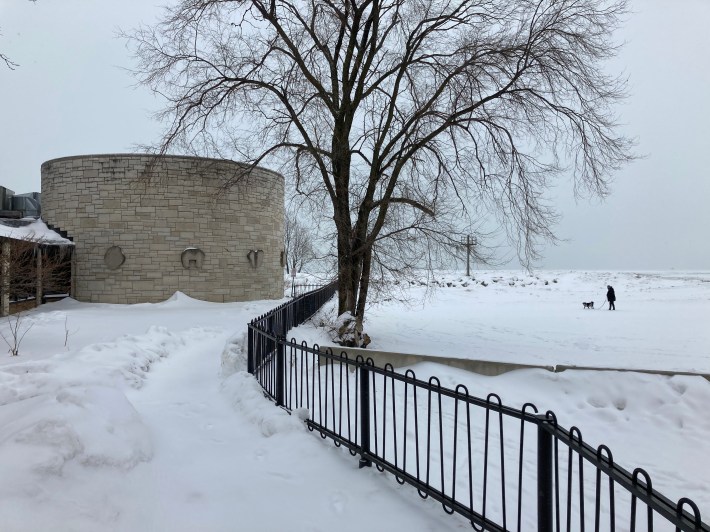
Skiing conditions are excellent as I shush across Osterman and Hollywood beaches, gazing at the fractured surface of the semi-frozen lake. Just south of Hollywood I pass the council rings at Meditation Point, where I've hosted countless bonfire hangouts this season as a safe form of socializing. While burning wood isn't technically legal there, the authorities seem to tolerate it: On the winter solstice, there were four separate fires going on at the point.
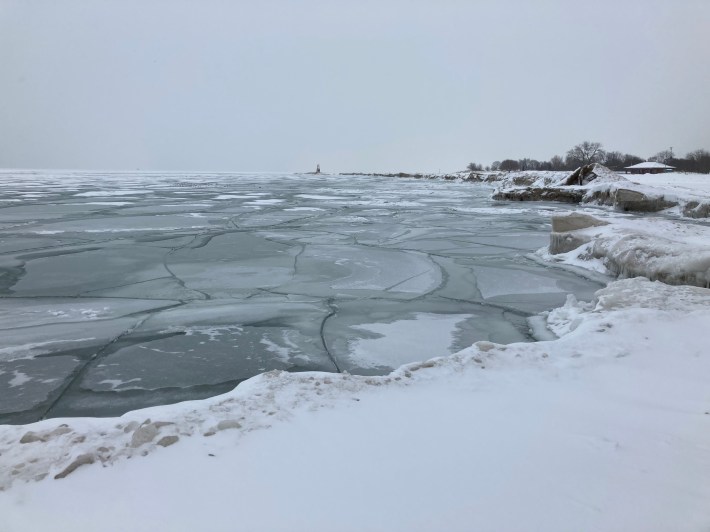
I continue south on the snowy shoreline revetment, accompanied by large black cawing crows, then shortcut across Foster Beach. I'm staying off the Lakefront Trail itself since, unlike most bikeways in this city, the path is plowed by the Chicago Park District on a near-religious basis. It's snowing now, but looking towards Montrose Harbor, I can just barely discern the outline of the Hancock Tower.
After skirting Montrose Beach and heading west past the harbor, where the skyline view has come into focus, I turn south to take the snow covered gravel road that leads towards the Waveland Clocktower. I encounter my first skier of the day, who's traversing the Sydney R. Marovitz Golf Course. "Nice conditions, huh?" I say.
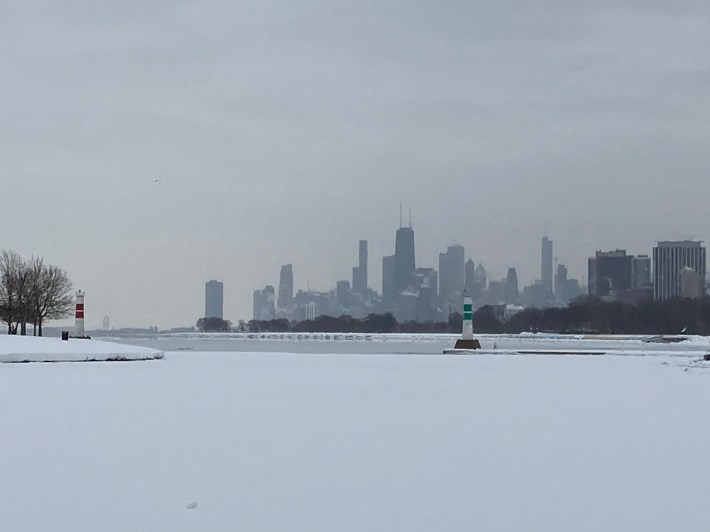
When the road reaches the Bill Jarvis Migratory Bird Sanctuary, I have to head west to the Lakefront Trail to get past Belmont Harbor. I pass a bench that's covered with birdseed, and the squirrels that are feasting on it don't flee when I come close to snap their photo.
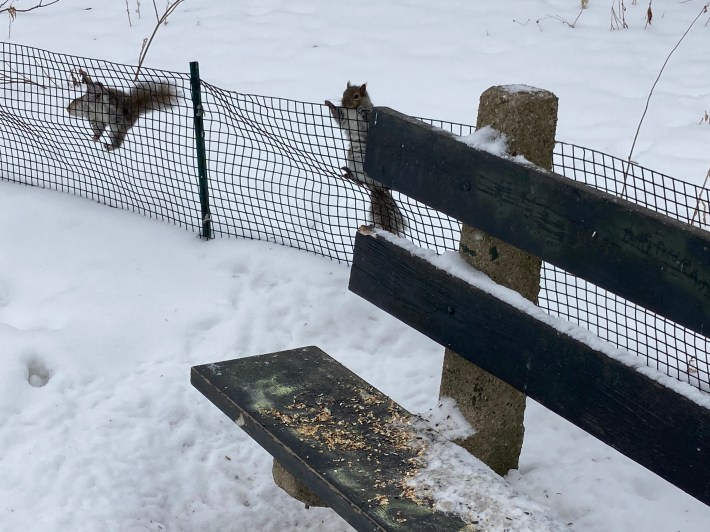
Skiing parallel to the path, I visit the colorful Kwa-Ma-Rolas totem pole, which is actually a replica of the original artwork by the Kwakiutl Indians of Vancouver Island, donated to Chicago in 1929 by Kraft Foods founder James L. Kraft.
A few blocks south at the Belmont rocks, a longtime LGBTQ gathering place, stands another monumental sculpture. Keith Haring's 30-foot-tall green figure "Self-Portrait" is the centerpiece of the AIDS Garden, a tribute to lives lost to HIV, plus those currently fighting to eliminate the disease.
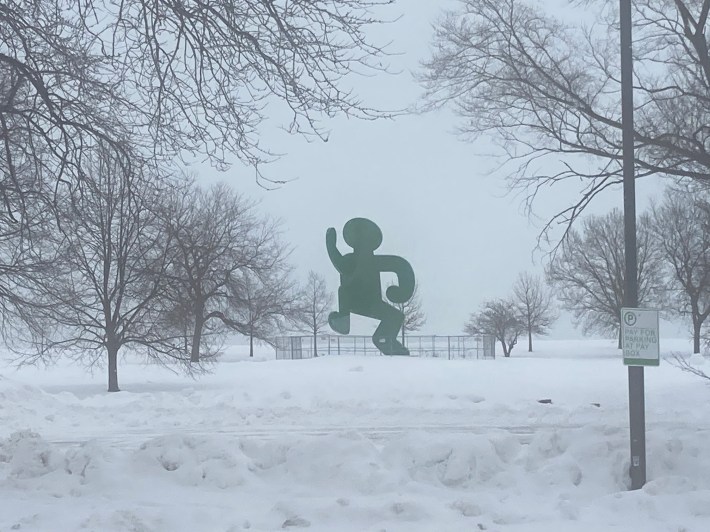
Just north of the Diversey bridge stand three more sculptures, including two highlighted this month by the city-created Chicago Monuments Project as being among 41 potentially controversial artworks on park district property "identified for public discussion," presumably because they are portrays of Native Americans done by white sculptors. While some monuments on the list depict American Indians as murderous or servile, to my non-Native eyes, these two seem to be respectful portrayals.
"The Alarm," which shows a Native family, was commissioned in 1880 by former fur trader Martin L. Ryerson, who dedicated the work to "The Ottawa Nation of Indians — my early friends."
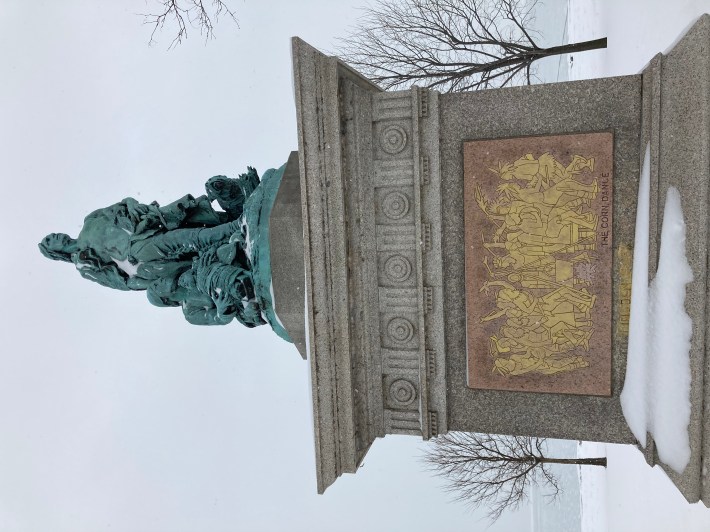
And "A Signal of Peace," sculpted in 1890 by Cyrus E. Dallin, which depicts a man on horseback with a feathered headdress and upraised staff, was donated to the city by arts patron Lambert Tree with an explicitly anti-racist intent. Tree wrote that the monument was a tribute to Native Americans who had been "oppressed and robbed by government agents, deprived of their lands… shot down by soldiery in wars fomented for the purpose of plundering and destroying their race, and finally drowned by the ever westward tide of population."
The monument committee, which includes three enrolled citizens of Native tribes, will make a decision on whether these pieces "warrant attention or action," informed by public input.
The third sculpture was also controversial, but for a totally different reason. Artist John Henry's "Chevron," a lofty, blue windmill-like structure, formerly stood on private property at Burling and Armitage in Lincoln Park, until too many neighbors complained that it was an eyesore. It was relocated to the lakefront in 2015.
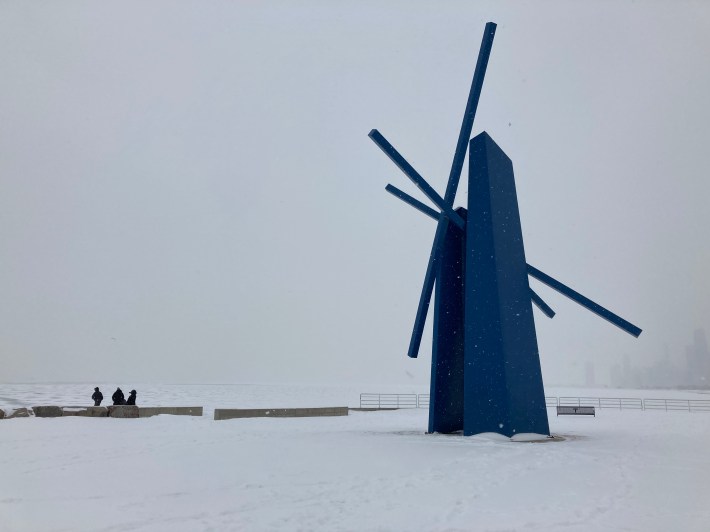
Continuing south to Fullerton, I'm at Theater on the Lake, formerly a day nursery for kids with tuberculosis. The statue "Charitas" by Ida McClelland Stout, a bronze work depicting a woman carrying two children, was installed by the facility in the early 1920s, one of Chicago's few 20th Century monuments by a female artists. It was put into storage in 1939 during a Lake Shore Drive reconstruction project, and reinstalled in 2016 as part of a rehab of the theater.
I continue along a narrow strip of snowy land between the plowed path and eight-lane LSD until I come to the North Avenue beach house, disguised as an old-timey steam ship. Nearby is Boris Gilbertson's mid-century modern Chess Pavilion constructed in 1957 of concrete and Indiana limestone with a wing-like canopy, flanked by five-foot-tall king and queen sculptures.
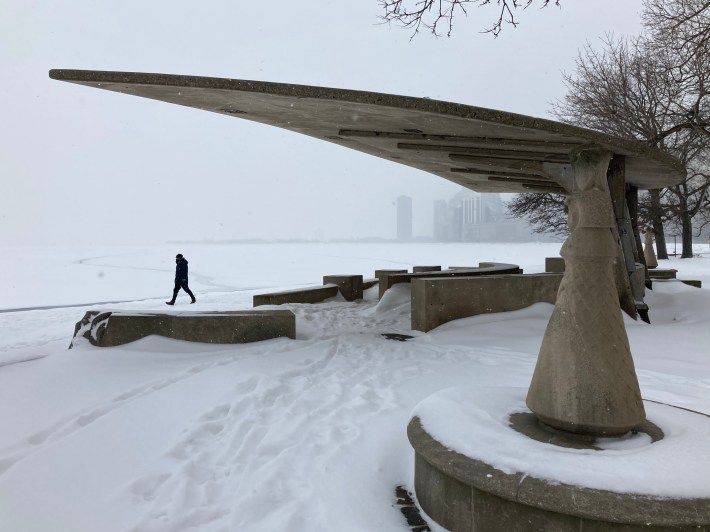
The trail is officially closed between North and Ohio due to icy conditions, but it's smooth sailing as I head towards the famous vista of the Hancock and the giant Old English sign for the Drake Hotel. The notorious Oak Street curve, where high waves have nearly dragged many trail users into Lake Michigan, is a different story, but the lake is pretty much frozen here, or at least totally still, so the only issue is navigating the ice boulders that hug the shoreline.
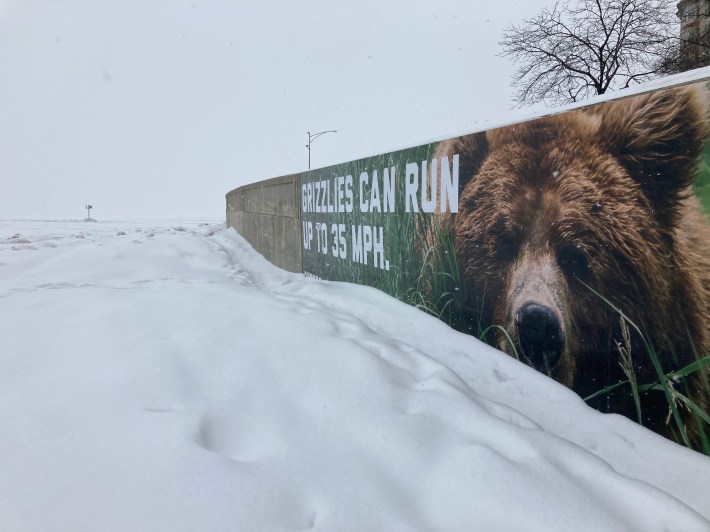
In front of me at Grand Avenue looms Lake Point Tower, the exclusive high-rise with a Y-shaped crossed section, which has been home to many Chicago pro athletes, plus actors Mickey Rooney, Kurt Russell, and Goldie Hawn; singer Helen Reddy; and shock rocker Alice Cooper.
Next to it is the Navy Pier Flyover, a $60 million-plus bike-and-pedestrian overpass that has taken almost twice as long to complete as the Golden Gate Bridge, although the Chicago Department of Transportation promises it's nearly finished. CDOT is currently tunneling through one of LSD's Art Deco river bridge houses to make room for widening the trail to 16'. I ski up the unplowed flyover, but have to unclip to cross the river.
Following the curve of the shoreline, I continue on the snowy edge of Monroe Harbor, with a backdrop of Michigan Avenue's cliff of high-rises. Just south of Buckingham Fountain stands Mark di Suvero's gnarly-looking rusty steel kinetic sculpture "Magma," installed in 2016.
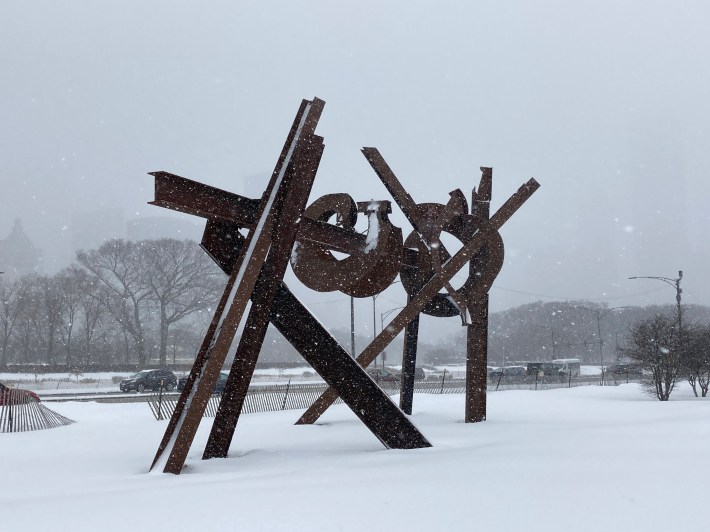
I round the Shedd Aquarium on the snowy "seawall" below the Lakefront Trail, pass by the Adler Planetarium, and stop for a snack of chocolate chip cookies and piping hot ginger tea. (The Thermos is a wonderful invention.)
Nearby is the Italo Balbo Monument, a 2,000-year-old Roman pillar donated to Chicago in 1933 by Benito Mussolini, according to its inscription, "in the 11th year of the Fascist era." The gift commemorated the trans-Atlantic flight to our city by Mussolini's air commander and Blackshirt leader Italo Balbo. In 2017, following the racist violence in Charlottesville, there was a movement by aldermen to relocate the pillar and rename Balbo Drive, but they ultimately caved to pressure from local Italian-American leaders who viewed Balbo as a hero. The pillar is on the Chicago Monument Project's list, so hopefully in this current age of anti-fascism, that public discussion will finally spur city officials to get rid of these tributes to murderous totalitarians.
A couple blocks south, families are frolicking on the Soldier Field sled hill. As I'm snapping a photo, my phone battery dies, perhaps partly from the cold. I slog a couple more miles along the revetment past the black monolith of McCormick Place and 31st Street Beach. But by the time I reach 35th it's getting dark and my body is complaining – among other things, it feels like I might lose my right-middle toenail – so I decide to catch the CTA back north and complete the trip the following weekend.
I return the following Saturday, February 20, to take advantage of the plentiful snow – 18 more inches had fallen that week – returning to the elegantly serpentine 35th Street Bridge. Just west of the span stands the tomb of Illinois senator Stephen Douglas. The 96-foot-tall structure features a column topped by statue of the "Little Giant," a who stood only 5'4" but was a commanding presence in politics. Douglas is famous for arguing to allow the expansion of slavery to new U.S. territories during his 1858 debates with Senate challenger Abraham Lincoln, the anti-slavery candidate.
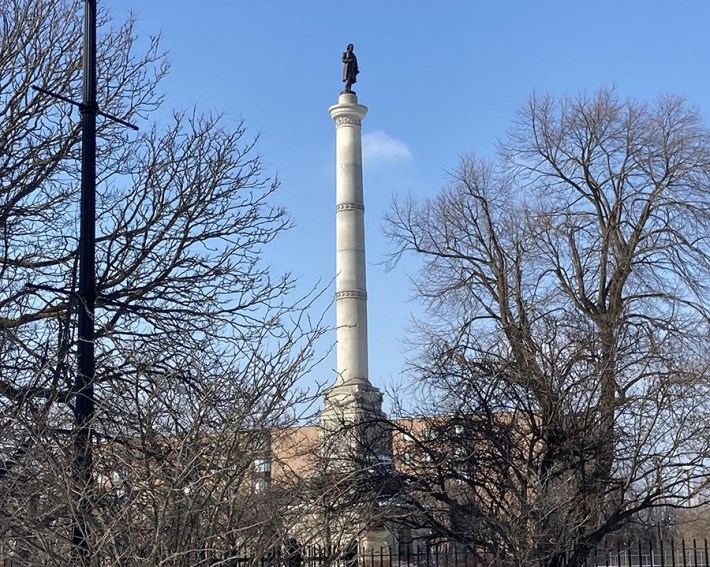
The Chicago Monument Project has identified all five statues of Lincoln on park district property as being potentially problematic, largely due to comments he made during the debates reassuring white voters that, while he opposed slavery, he didn't support equal rights for Black people. (His position later evolved, thanks in part to lobbying by abolitionist Frederick Douglass, who recently replaced Stephen Douglas as the namesake of Chicago's Douglass Park.) Ironically, unlike the statues of Lincoln, there's little risk of the monument to a slavery apologist being removed, since it's not on parkland but rather a state historic site.
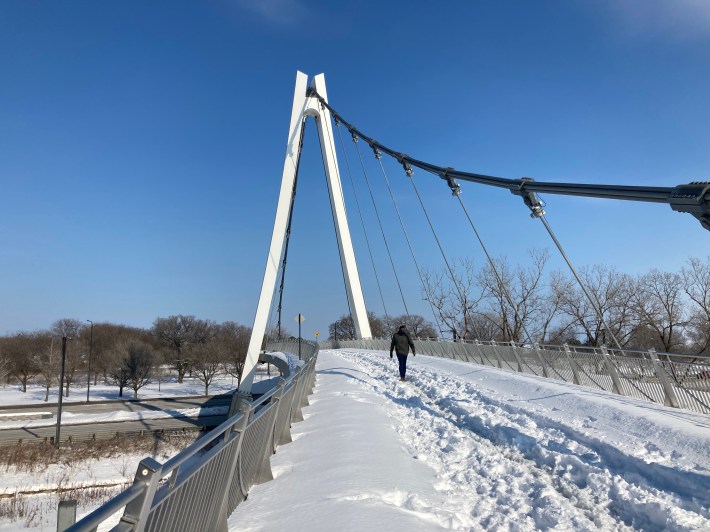
After heading to the lakefront, I come across "La Ronda Parakata," a ring-shaped sculpture with a butterfly motif, with seating made of dead ash trees, created by artists Hector Duarte and Alfonso "Piloto" Nieves. It's one of a few "Gathering Spaces" recently installed along the Burnham Wildlife Corridor.
As I head south on the revetment by tall, scrubby vegetation, conditions are excellent and the lake is totally still, possibly frozen through. At 41st ski across Oakwood Beach and pass by another giant new bike-pedestrian bridge, a curving cobalt structure I've dubbed "The Blue Wave."
Approaching the 47th Street bridge, I see a couple of teens flop down in the snow and then recline there for a while, gazing at the sky. By tiny 49th Street Beach, there's a comfort station covered with a colorful mural of faces, flowers, and seagulls. Continuing towards Hyde Park, there are lots of University of Chicago students and families out enjoying the sunshine.
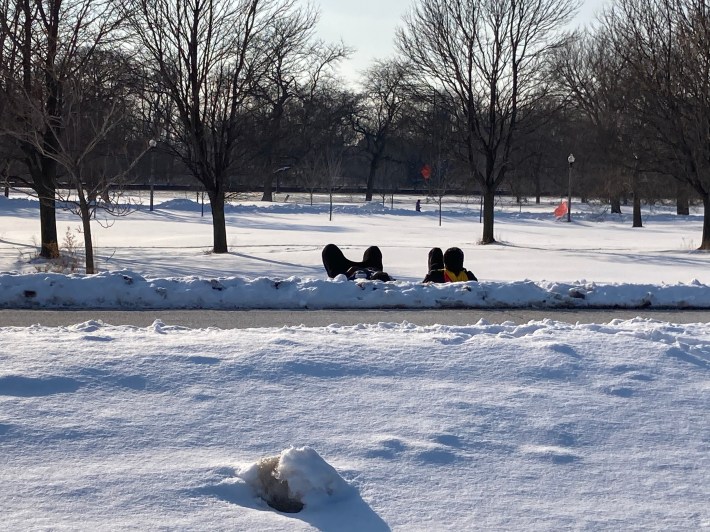
Near 53rd there's another rusty, hulking Mark di Suvero kinetic sculpture called "Destino." Created in 2003, it features a v-shaped top that can rotate when a stiff wind blows.
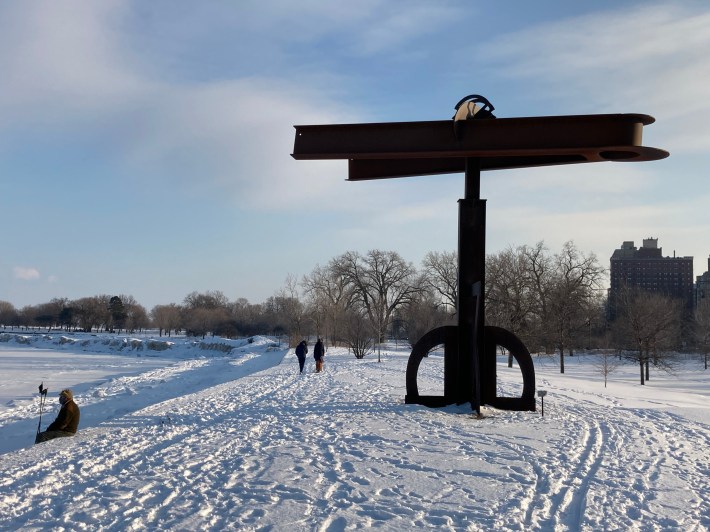
Two blocks south at Promontory Point I encounter the David Wallach Memorial Fountain, created by husband-and-wife team Frederick Cleveland Hibbard and Elisabeth Haseltine Hibbard, which, when running, provides refreshment for people, dogs, and birds. It's topped with an adorable bronze faun.
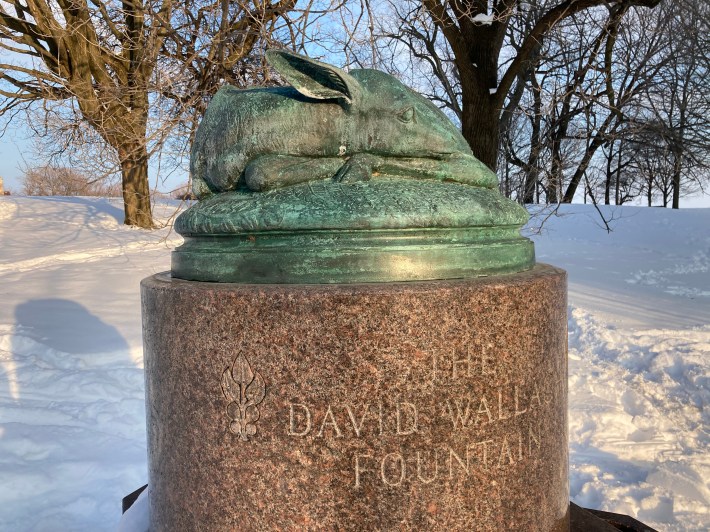
At 57th I glide past the Museum of Science and Industry, the only remaining remaining building from the 1893 World's Columbian Exposition. Originally a semi-temporary plaster-and-brick structure, the Palace of Fine Arts, it was eventually recast in limestone for permanence.
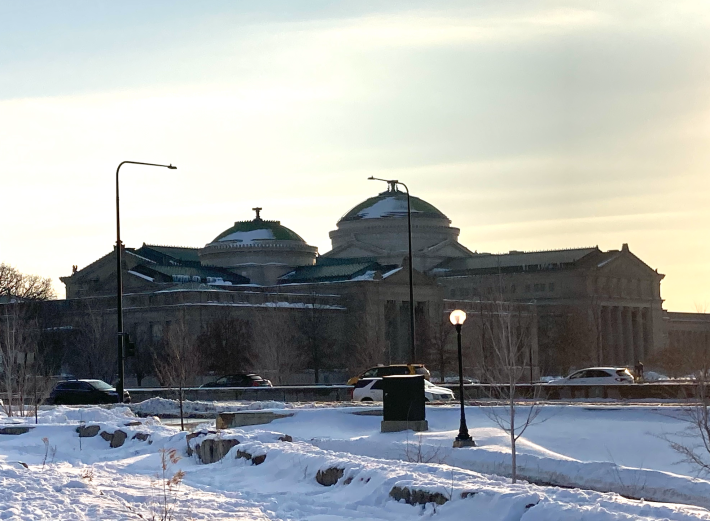
On the bridge at the mouth of 59th Street Harbor I notice an ornate green lamp -- perhaps a leftover from the World's Fair? 63rd Street Beach has a similarly elegant bathing pavilion, a Classical Revival building with open balconies, designed by Central Park architects Olmsted & Vaux and built in 1919.
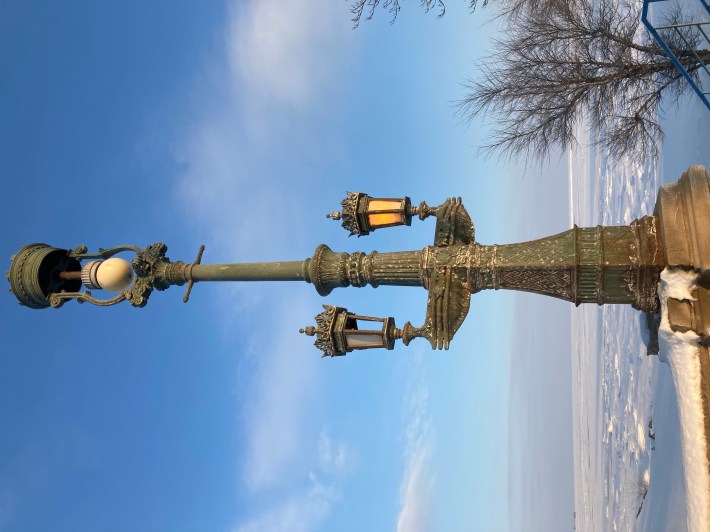
At 64th I stop to photograph the sun setting next to "Fishing Eagle," which artist Jim Long carved out of a dying Ash tree, still rooted in the ground, with a chainsaw in 2014.
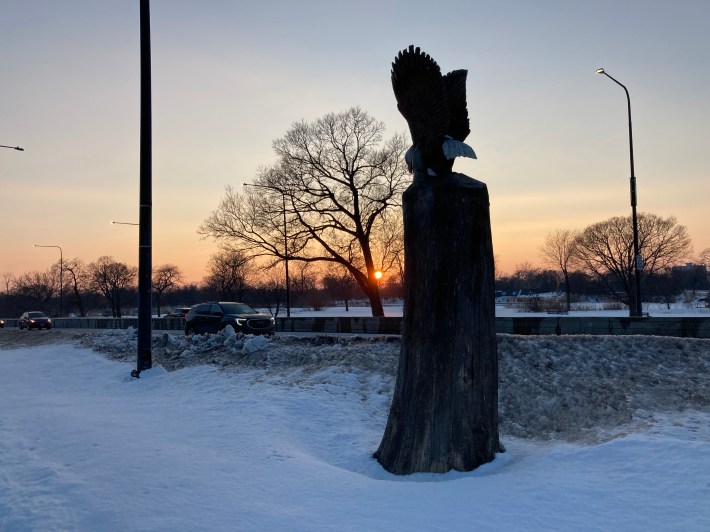
Then I cross the Animal Bridge, which connects Jackson Park's outer and inner harbors, created by Peter J. Weber and Thomas E. Hill, built in 1904, and adorned with carvings of the heads of hippos and rhinos, faces of water gods, and ship's prows.
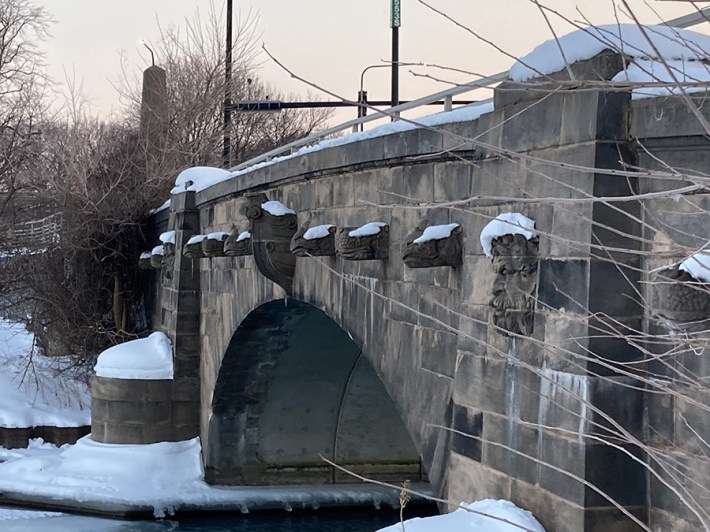
From there the trail curves southeast along Marquette Drive, past La Rabida Children's Hospital, and a Daniel Burnham-designed, classically-inspired park pavilion that has been allowed to crumble for many years. I catch one more glimpse of the downtown skyline from the snow drift-covered beach at Maquette, 67th, and South Shore Drive.
Four more blocks takes me to the South Shore Cultural Center, my finish line. It's an imposing structure, built as a country club in the early 1900s, with a design partly inspired by a club in Mexico City. Early members included retail tycoons Marshall Field and Montgomery Ward. African Americans and Jews were barred from membership in the private club into the 1970s, when it went out of business and the park district bought the property, turning it into a highly inclusive community center. Nowadays, at least in non-pandemic times, the cultural center hosts a wide array of recreation and arts programming, as well as stables for Chicago Police Department horses.
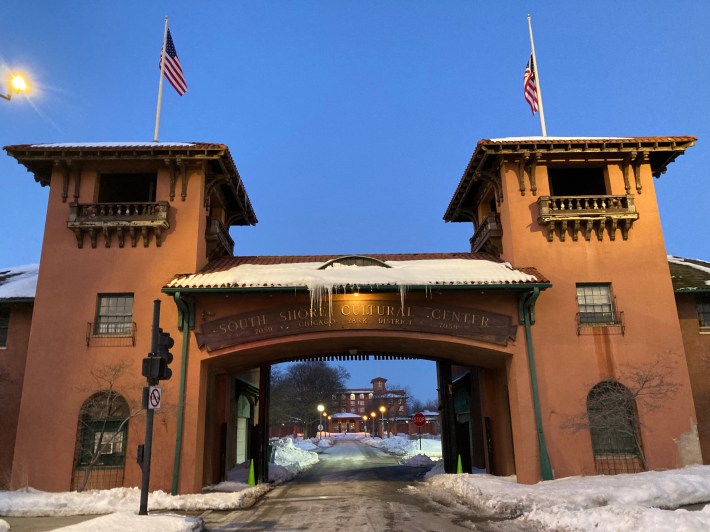
The day after I complete my odyssey on skis, the temperature hits 38 Fahrenheit, and even warmer weather is predicted for the coming week, promising to melt all the mounds. I'm glad I took advantage of the primo skiing conditions while they lasted, and got an education on coastal, sometimes controversial, public art as part of the bargain.
In addition to editing Streetsblog Chicago, John writes about transportation and other topics for additional local publications. A Chicagoan since 1989, he enjoys exploring the city on foot, bike, bus, and 'L' train.
Stay in touch
Sign up for our free newsletter
More from Streetsblog Chicago
It’s electric! New Divvy stations will be able to charge docked e-bikes, scooters when they’re connected to the power grid
The new stations are supposed to be easier to use and more environmentally friendly than old-school stations.
Today’s Headlines for Tuesday, April 23
Communities United: Reports of Bikes N’ Roses’ death have been greatly exaggerated
According to the nonprofit shop's parent organization, BNR has paused its retail component, but is still doing after-school programming and looking for new staff.
